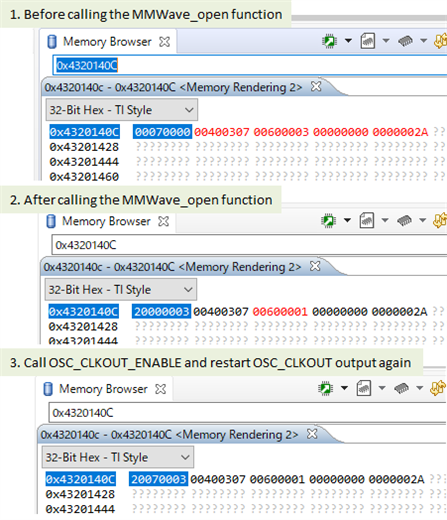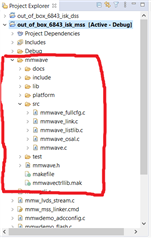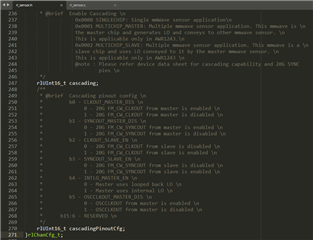Other Parts Discussed in Thread: AWR1243
Hi,
I want to output 40MHz clock to A14 OSC_CLKOUT pin on IWR1843 for debugging purposes based on SDK 3.5.0.4 demo.
By calling the following function in MmwDemo_initTask, it was confirmed that the 40MHz clock was output from the OSC_CLKOUT pin after the reset was released.
void osc_clkout_enable(void)
{
uint32_t *regAddr = (uint32_t *)0x4320140C;
uint32_t regValue;
//https://e2e.ti.com/support/sensors-group/sensors/f/sensors-forum/929455/awr1843-how-to-turn-on-pin-function-osc_clkout?tisearch=e2e-sitesearch&keymatch=OSC_CLKOUT
//For the analog output on pin A14 you can write the register "0x4320140C" bit[26:16] with value '0x7' to enable the 40Mhz clockout on the OSC CLKOUT pin .
SOC_MPUDisable();
SOC_MPUDisableBackgroundRegion();
SOC_MPUSetRegion(SOC_MPU_REGION12);
SOC_MPUSetRegionBaseAddress(0x4320140C); /* required memory to read by the application */
regValue = *regAddr;
SOC_MPUSetRegionTypeAndPermission(SOC_MPU_NORMAL_OINC_NONSHARED, SOC_MPU_PRIV_RW_USER_RW_EXEC);
SOC_MPUSetRegionSizeRegister(SOC_MPU_REGION_ENABLE | SOC_MPU_32_BYTES);
SOC_MPUEnableBackgroundRegion();
SOC_MPUEnable();
*regAddr = regValue | 0x00070000;
}
However, when I execute the sensorStart command after configuration, the OSC_CLKOUT output stops.
I think that the register of the above code is overwritten by the sensorStart command, but I don't know where in the SDK it is overwritten.
Please tell me how to continue the OSC_CLKOUT output after the sensorStart command.
Best regards,
Hiroyuki Taguchi






